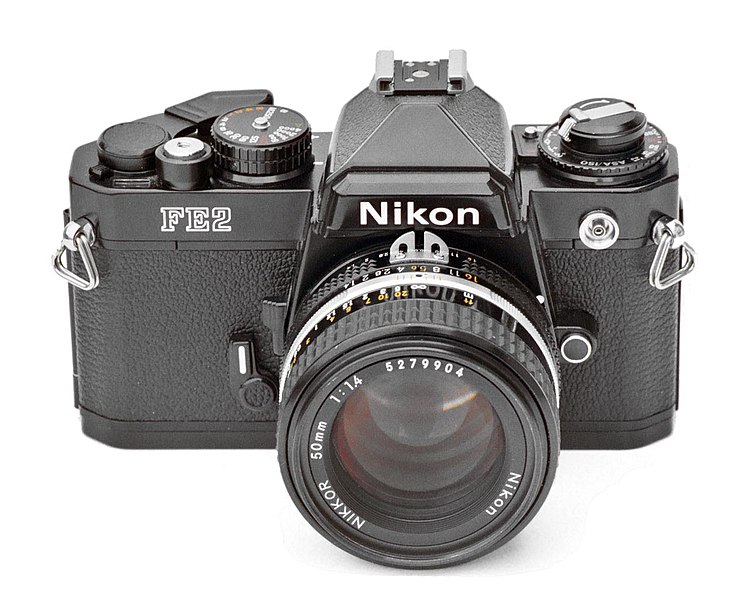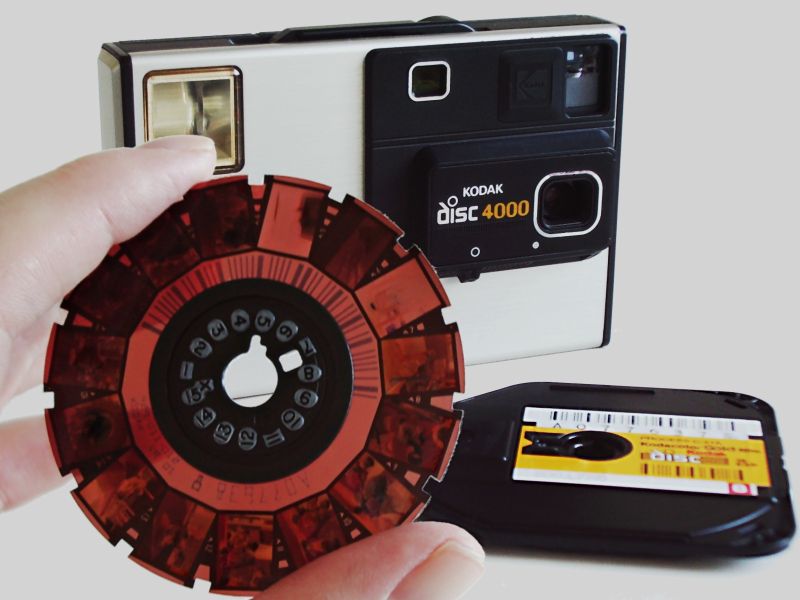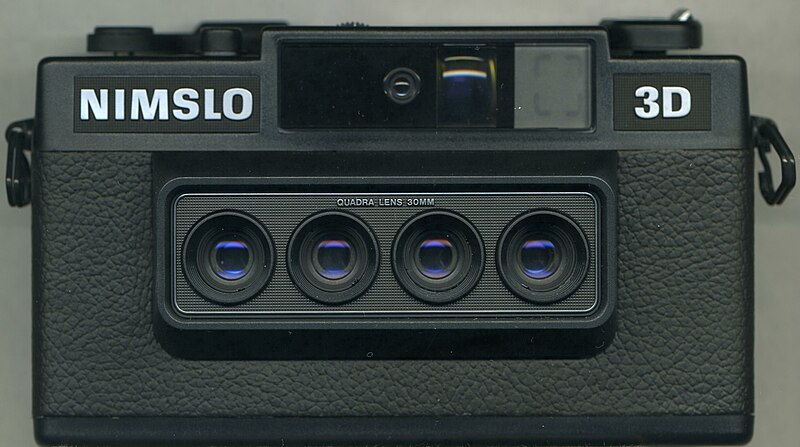With photography being one of my passions in 1983 just as much as it is today, I thought I'd write about some of the developments (pun intended) in the photography world of 30 years ago. The period was one of intense competition between five major Japanese camera brands, as each tried to outdo the other with their flagship SLR (single-lens reflex) camera models. By 1983 however, SLR sales were starting to decline and makers were looking for new innovations to maintain their share of the market. The 35mm camera brand most favoured by professionals working in the field was Nikon, and their most recent professional model, the F3 had been released three years earlier to positive response. A variation on that model, the toughened-up F3/T (for 'titanium', used in its construction) was issued during 1983. Intended for use in extreme conditions where reliability was a must, it was available in black finish and also champagne coloured finish.
For the enthusiast or serious amateur, Nikon also released two other models in 1983. The FE2 was an improved version of their popular FE, featuring aperture-priority automatic and manual, but with a maximum shutter speed of 1/4000 second. This was made possible by a revolutionary shutter design first seen on the FM2 of the previous year, and the design also allowed flash to be used at a maximum speed of 1/250 second. (Most SLR cameras of the time were only able to use flash at a speed no greater than 1/60 second; a handful did go to 1/125 second). The rugged design of Nikons meant that even models such as the FE2 or FM2 found favour with professionals.
Nikon FE2 (Wikipedia)
Their other model released that year was the FA, the company's first venture into 'multi-mode' SLR production. This sector of the market had been sewn up by rivals Canon for the five years previously, as their flagship A-1 camera sold by the lorryload. Multi-mode meant that the camera could be used in more than one automatic mode; aperture priority (the user sets the lens aperture while the camera selected the correct shutter speed), shutter-speed priority (the other way around), or programmed mode where the camera would calculate the exposure selecting both aperture and shutter speed. The FA also had a new trick up its sleeve; its metering system was extremely advanced for the time and could calculate the correct setting using different segments of the scene. This is known today as 'matrix' metering, and was revolutionary in 1983. Almost every modern camera made today uses a variation of this system.
The Nikon FA (Wikipedia)
Canon meanwhile had tried a different approach with their latest SLR models. The T-series of SLRs began in 1983 with the launch of the T-50; this model was aimed at the photographer who wanted a first SLR and came with programmed exposure only (no manual mode) and in addition to that, it had a built-in power winder. The T-50 was soon overshadowed by subsequent models; the T-70 offered more control while the later, ultra-sophisticated T-90 became a design classic.
Canon T-50 (Wikipedia)
Pentax were a very popular choice of camera brand for enthusiasts in the UK at this time thanks largely to their ME-Super model of 1980, one of the best-selling camera models of the day. The Super-A, released in 1983, took things a stage further, once again offering multi-mode exposure systems and with a push-button system of operation similar to that of the ME-Super, it appeared to be the logical upgrade for ME-Super users. However, to achieve the multi-mode functionality, it was necessary for Pentax to modify their lens mount, adding electronic contacts to be used with a new range of lenses. Although existing lenses lacking the contacts fitted the new model. it meant that existing Pentax users were unable to take advantage of the Super-A's new features. It still won European Camera of the Year however, and it was soon accompanied by a slightly cheaper model, the Program-A.
Pentax Super-A (Wikipedia)
Meanwhile, Olympus had finally unveiled two new flagship models intended to replace their ageing SLR line-up. Their manual OM-1 and automatic OM-2 had been in production since the early 1970s, and although revolutionary for their day, other makers had caught up with them and in some cases were overtaking them. The OM-4 of 1983 was intended to be the successor to the OM-2, still offering automatic and manual exposure, it also had the most sophisticated metering system yet seen on an SLR camera. In short, it was able to 'spot-meter' up to eight different points and work out the correct exposure from an average of these. In addition, it could also 'spot' the darkest or lightest part of a scene and adjust its setting accordingly. The innovation didn't end there; Olympus had licked the problem of flash with focal-plane shutters once and for all with their new flashgun designed specifically for the OM-4. This flashgun allowed operation at any shutter speed; SLR cameras had a maximum speed where the shutter would fully open, beyond that the shutter would only open partially, with a 'slit' of light moving quickly across the frame. The new flash, called 'Full Synchro' worked by firing a continuous burst of light all through the shutter's motion, so the image would be correctly lit across the whole frame. The camera was a sensation and remained in production until 2002, albeit in a revised form with a titanium body (and higher price to match). The OM-3 (the successor to the manual, mechanical OM-1) boasted the same metering and flash features but without the automatic exposure; produced in limited quantities this model is now a much sought-after collectors' item.
Olympus OM-3 (Wikipedia)
The last of the major SLR makers, Minolta, were still two years away from launching their autofocus SLR (the Maxxum 7000) which would change the photography scene for good. They had a multi-mode SLR out already (the X-700, released in 1982) and their X-570 was a lower-specification, lower-priced variation of that. They were very much the lesser lights of the photography scene back then, but their autofocus 7000 and 9000 models which came later in the decade changed all of that and caught their rivals napping.
Autofocus had arrived with compact cameras by this time, a popular model was Canon's 'Sure Shot' 35mm with motor wind and a built-in flash to go with its autofocus ability.
Canon Af35M 'Sure Shot (Wikipedia)
However, early attempts at bringing autofocus to SLR cameras were clunky efforts, with the mechanisms often built into specially-developed lenses, adding extra bulk. The Pentax ME-F and Olympus OM-30 were SLR models with the ability to 'confirm' correct focus with an indicator in the viewfinder, but needed such a special lens to offer true autofocus. Nikon also offered a variant of their professional F3, the F3AF, but this was a very specialist and expensive item. The real revolution came two years later, as described above.
In the snapshot market, Kodak had launched Disc film and a whole new range of cameras. This film came in a format resembling a computer disk, inside was a wheel containing 15 individual frames of film. The makers trumpeted this as an innovative design allowing for neater, smaller cameras, however the format flopped badly since the negatives it gave were a very tiny 11mm x 8mm. This meant considerable enlargement to give even small prints, and the results were unacceptable to most users. Kodak got away with this trick a few years earlier with 110 film, a small drop-in cartridge offering negatives of 17mm x 13mm (compared to 24mm x 36mm on a 35mm film negative), which meant they could sell less film for the same money. However, by the time of Disc, the consumer had wised up to that ploy.
Kodak's short-lived Disc film and camera (Wikipedia)
Another innovation which failed to catch on was 3D stereo photography. The Nimslo camera (with four lenses set alongside each other) was finally launched this year after a lot of hype, but although it took conventional 35mm film, the lack of photofinishers geared up to handle the printing of these snaps meant that the product bombed, and the company soon collapsed.
Lastly, in the movie camera market, the whole industry had shifted to video by this time as video maker JVC produced VHS-C, a cut-down version of the VHS tape format (which would play in a conventional VHS player via an adapter) making smaller camcorders possible. Rival Sony responded with Video 8, a small-format tape designed specifically for their camcorders. Camcorders all but killed off the cine camera, as the Super-8 cine film format passed into history. In years to come, digital still photography would do the same thing to conventional film cameras.
A VHS-C cassette with adapter allowing it to be played in a standard VHS video machine (Wikipedia)








Thanks for the blog. I'm writing a novel set in 1983 and this is so helpful!
ReplyDeleteYou're welcome - this blog has lain dormant for a while as real life got in the way, and I didn't add everything I intended to (I may return to it as time permits) but I am happy you got some use from it.
Delete